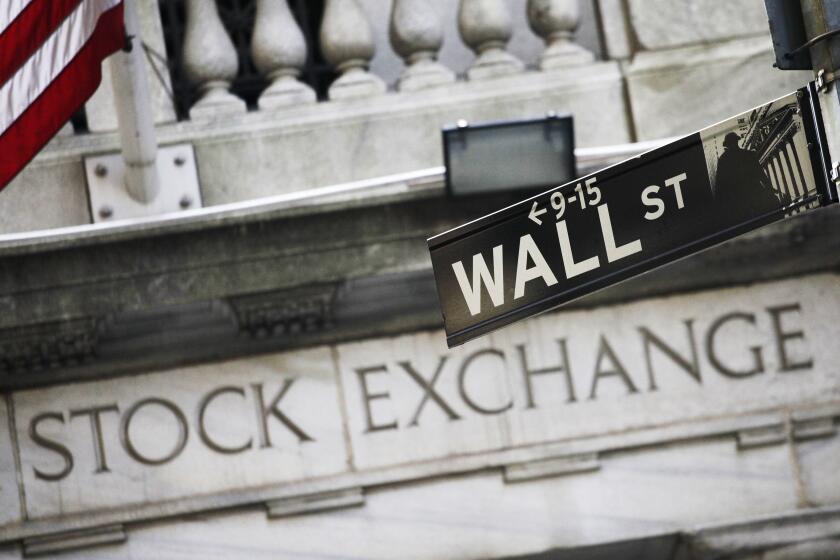Aligned With the Universe : Guardian’s Albers Works From Bottom Up and Top Down
- Share via
Charles E. “Chuck” Albers has run the Guardian Park Avenue Fund since its inception in 1972. During that time, the fund has produced an average annual return of 15.69% as of Sept. 30, hammering the Standard & Poor’s 500 and various other measures.
The professorial Albers continually strives to refine his computer models and now relies on both bottom-up models, which help him pick individual stocks, and top-down models, which lead him into broad categories of stocks. Lately, he likes blue-chip companies, with six of his 20 largest holdings among the Dow Jones industrials. He spoke in his New York office with Times staff writer Thomas S. Mulligan.
Times: One of your brilliant moves recently was away from smaller-capitalization stocks and into high-quality, very large-cap stocks. How did this happen?
Albers: It’s not one decision; it’s a long-term process. Since 1982, when this bull market started, we’ve had only one really poor year, and that was 1990. What happened was, the fund was tilted toward small-cap stocks, and in 1990 those stocks did very poorly on a relative basis. The big-cap growth stocks were up that year, but everything else suffered.
Our bottom-up stock selection process had been doing a great job of helping us to select individual stocks, but because of this experience in 1990 it became obvious that I had to develop a systematic way of thinking about style issues, which are top-down issues. So we developed models to help us predict issues of style, questions such as large cap versus small cap, growth versus value, high quality versus low quality.
By the first quarter of 1995, our new models began giving us very clear signals that the style tilt that was most likely to be successful in the period ahead was large-cap growth, high-quality companies. Beginning in the first quarter of 1995, we took the bull by the horns and implemented the message we were getting from our models.
During the first half of the year, the median weighted market cap of stocks in our portfolio rose dramatically from $6 billion to $14.9 billion. And by the end of the year, it was up to $24.5 billion. And today, the figure is $35.9 billion.
Times: Now, I notice, the smallest company among your top 20 holdings is Green Tree Financial, with a market capitalization of $5.5 billion. The others, such as General Electric, Exxon, Philip Morris, Coca-Cola, are among the world’s largest corporations. Are you sticking with your model?
Albers: I don’t have any plan to change our style in the foreseeable future. I think at this time, with our portfolio titled a bit toward larger-cap, higher-quality companies, this is aligned with the way of the universe. We’re positioned correctly, if I may say so, and our relative performance this year has been solidly up there in the top quartile.
Times: What about the market fibrillations of the last week?
Albers: That’s just December weirdness, and you should not interpret that too significantly. The overarching theme, as we see it, is that the portfolio should be tilted toward higher-quality stocks. Profit growth in 1997 is not going to be that terrific--maybe flat to 5%. It’s a tough environment, and the better-quality companies are going to produce better earnings.
Times: Of the stocks you’ve discarded recently, AT&T; is prominent, as is Hewlett-Packard. Why did you sell?
Albers: They have stumbled; they have lost their underlying positive momentum. One of our big disappointments this year was AT&T.; Early on, we decided that Lucent--AT&T;’s technology spinoff--had great potential, and we decided that the most efficient way to own Lucent would be to have a large position in AT&T.; We thought that Lucent had excellent prospects and that AT&T;’s long-distance business at least could not hurt us.
Lucent has been enormously successful. We got it at $25, and it is now $49. But we were wrong about AT&T; because we misjudged how poorly the long-distance phone business was going to do.
Hewlett-Packard is a wonderful company, very successful, but it is quite large and is surrounded by a lot of highly motivated and nimble competitors.
Over the summer, it had several disappointments, both in new orders and new products, and there were progressive reductions in earnings expectations.
Times: You’re thought of as a quantitative stock-picker who goes with his computer models instead of his gut.
Albers: As a broad generality, yes, I respect my models, and a great deal of the time I do what they suggest. Sometimes all the models are not perfectly aligned--particularly at this time year when we have certain crosscurrents--and that is where the art comes in.
Times: How is this time of year different?
Albers: In the January quarter the normal tendency is for the more value-oriented and lower-quality stocks to do better. During the other three quarters of the year, typically, stable growers and good-quality stocks tend to do better.
Times: Do you know the reasons, or do you need to?
Albers: The reasons, I suppose, are embedded in human psychology. We think we have some theories which help explain them, but to me the most important thing is that this is reality. This is the way the world works, and if you try to deny it, you’re a darn fool.
Times: But can you be a value player for one quarter and something else the rest of the year?
Albers: We have one model that ranks stocks in the first quarter and a different model that ranks stocks during the other three quarters. Right now, we’re running both models, and the poor old portfolio manager--that’s me--has to look at both of them and figure out how to adjust. You can’t turn the whole portfolio over and reverse it again in March--that would be impossible to implement.
Times: But turnover does increase toward year-end?
Albers: Yes, December is by far my busiest month. Over the last 10 years, our annual average portfolio turnover rate has been approximately 60%--quite a bit lower than the typical growth fund, where it is between 75% and 125%. We’re not deviating from our long-term strategy in that respect, but we get a little more aggressive in December. Then typically around March, we’ll move back toward a more normal position.
Times: What quantitative factors should individual investors be aware of?
Albers: It’s important to be aware that the style bias in your portfolio is going to have a significant impact on your performance. In 1996, the large-cap stocks have done extremely well, while the smaller-cap brethren have lagged way, way behind. And if you’re on the wrong side of that, your performance really would suffer quite a lot.
(BEGIN TEXT OF INFOBOX / INFOGRAPHIC)
Guardian Park Avenue
Strategy: Seeks long-term growth of capital by investing mainly in blue-chip stocks. Portfolio is structured according to computer models that identify biggest potential winners among stocks.
VITAL STATISTICS
Year to date total return: +24.6%
5-year total return, through Sept. 30: +133.3
Avg. general stock fund, 5-year return: +96.7
Five biggest holdings as of Nov. 30:
1. Merck 2. General Electric 3. Citicorp
4. Johnson & Johnson 5. Intel
Max. sales charge: 4.5%
Assets: $1.3 billion
Min. investment: $1,000
Phone: (800) 221-3253
Morningstar risk-adjusted
performance rating, 1-5: ****
Sources: Lipper Analytical Services, Morningstar Inc.
More to Read
Inside the business of entertainment
The Wide Shot brings you news, analysis and insights on everything from streaming wars to production — and what it all means for the future.
You may occasionally receive promotional content from the Los Angeles Times.










